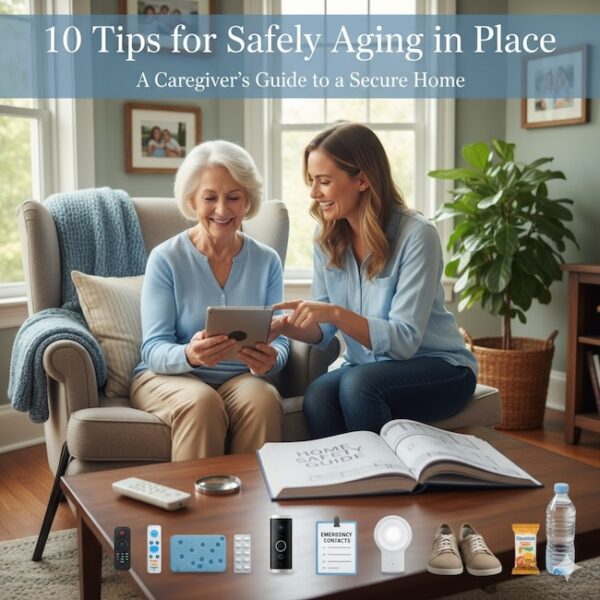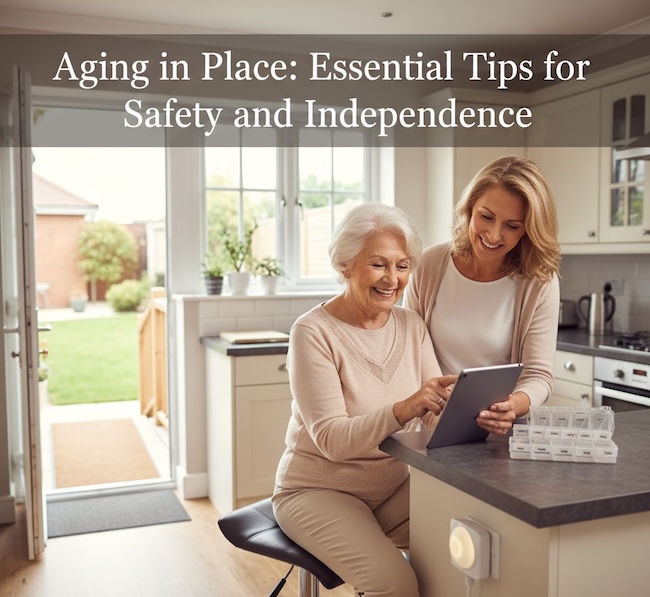Implementing the right strategies and support can make aging in place a reality for many older adults. Staying at home can promote independence, boost overall well-being, and help maintain a high quality of life.
Aging in place is an excellent option for many older adults who prefer the comfort of their own homes.

However, as their needs change with age, careful planning and regular adjustments are needed to ensure long-term safety and comfort.
By making proactive changes to put the right strategies and support in place, staying at home can promote independence, boost well-being, and help seniors maintain their quality of life.
10 Safety Tips for Aging In Place
1. Maintain open communication
As older adults age, their needs and health conditions can change.
Regular communication with family members, caregivers, and healthcare providers helps ensure their living environment remains safe and meets their needs.
- Check in regularly to discuss any physical or emotional changes.
- Encourage open conversations about mobility concerns, vision changes, or medication side effects that might impact safety.
Keeping lines of communication open is critical in addressing issues before they escalate.
2. Home modifications to prevent falls
Falls are one of the leading causes of injury among seniors, making home safety a top priority.
Modifications can range from simple fixes to larger projects, but all are crucial in preventing accidents.
- Install grab bars in the bathroom near the toilet and in the shower or tub.
- Place non-slip mats in areas prone to moisture, like the kitchen and bathroom.
- Improve lighting throughout the home, especially in hallways and staircases.
- Eliminate tripping hazards, such as loose rugs, clutter, and electrical cords.
These adjustments make it easier for older adults to navigate their homes confidently.
3. Implement a medication management system
As seniors age, they may take multiple medications daily, which can lead to confusion or missed doses.
Managing medications properly is essential to maintaining health and avoiding complications.
- Use a pill organizer with compartments for each day of the week.
- Set up reminders and alarms, or use mobile apps, to ensure timely medication intake.
- Schedule regular medication reviews with a healthcare provider to confirm that the current regimen is still appropriate.
Having a reliable system for medication management helps prevent dangerous mistakes and promotes better overall health.
4. Schedule regular health check-ups
Preventive care is essential in ensuring that older adults can age safely at home.
Scheduling routine medical appointments can help detect health issues early and provide necessary interventions.
- Arrange for in-home visits from healthcare providers or nurses when mobility is limited.
- Keep up with routine screenings, like vision, hearing, and bone density tests.
- Manage chronic conditions proactively with regular monitoring and medication adjustments.
Routine health check-ups ensure that older adults stay on top of their health and any emerging conditions are managed promptly.
VIDEO: 10 Tips for Aging In Place!
5. Optimize nutrition and meal planning
Proper nutrition is crucial to maintaining good health, but meal preparation can become more challenging with age.
Ensuring easy access to healthy food is vital for aging in place successfully.
- Arrange meal delivery or grocery delivery services, particularly for seniors with mobility issues.
- Prepare meals in advance that can be easily reheated.
- Consider hiring a part-time caregiver to assist with meal planning, shopping, or cooking.
A balanced diet rich in nutrients helps seniors maintain their energy, immune function, and overall well-being.
6. Encourage regular physical activity
Staying active is essential for older adults’ physical and mental health.
Even moderate exercise can help maintain mobility, improve balance, and reduce the risk of falls.
- Encourage daily walks or light stretching exercises to keep joints and muscles strong.
- Join exercise classes designed specifically for seniors, such as chair yoga or water aerobics.
- Consult a physical therapist for personalized exercise plans tailored to their mobility and health needs.
Incorporating regular physical activity into their routine can help older adults maintain independence longer.
7. Upgrade home security
A well-secured home promotes peace of mind for both older adults and their families.
With advances in technology, it’s easier than ever to enhance home security.
- Install a security system that includes motion detectors, door sensors, and surveillance cameras.
- Use smart doorbells that allow seniors to see and speak to visitors before opening the door.
- Ensure proper locks are installed on all doors and windows.
These steps reduce the risk of burglaries or unwanted visitors, allowing seniors to feel safe and secure.
8. Create a strong support system
Aging in place doesn’t mean aging alone.
Older adults need to have a strong support network to help them navigate daily challenges.
- Enlist family, friends, or neighbors to check in regularly.
- Hire professional caregivers or home health aides if needed, even on a part-time basis.
- Join local senior groups or activities to promote socialization and reduce isolation.
A robust support system ensures that seniors have someone to rely on when they need assistance, both physically and emotionally.
9. Leverage technology for safety
Technology can be a game-changer for aging in place.
There are various devices and services available to help seniors stay safe and independent.
- Wearable emergency alert devices allow seniors to call for help with the press of a button.
- Home monitoring systems can track movement and notify caregivers if an issue arises, such as a fall.
- Smart home devices, such as voice-controlled assistants, can help seniors with daily tasks like setting reminders or adjusting the thermostat.
Using technology effectively can add an extra layer of security and convenience, enabling seniors to live more comfortably at home.
10. Plan for the future
Even when aging in place is going well, plan for the future.
Circumstances can change, and having a plan in place ensures that seniors are prepared.
- Consider long-term care options, such as in-home care services, assisted living, or skilled nursing facilities, even if they’re not needed yet.
- Prepare legal documents, such as a will, power of attorney, and healthcare proxy, to ensure your wishes are carried out.
- Discuss finances with family members or financial advisors to budget for future needs.
By planning, older adults and their families can avoid stress and ensure their needs are met as they age.
Recommended for you:
- How to Talk with Parents About Aging: 5 Tips and Conversation Starters
- Aging at Home: Essential Tips for Safety and Independence
- What To Do When Aging Parents Refuse Help They Need
References: AARP, Alzheimer's Association, CDC, Mayo Clinic, National Institute on Aging
About the Author

Lance A. Slatton CSCM – Known as “The Senior Care Influencer” is a Writer, Author, Influencer, and Healthcare professional with over 20 years in the healthcare industry. He is a senior case manager at Enriched Life Home Care Services in Livonia, MI. Lance A. Slatton is also the host of the award-winning podcast & YouTube channel All Home Care Matters.













